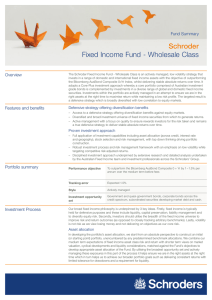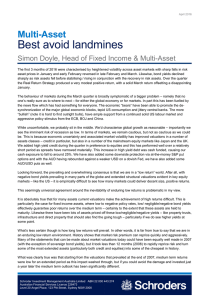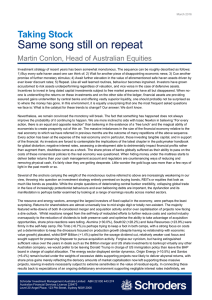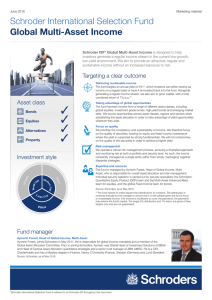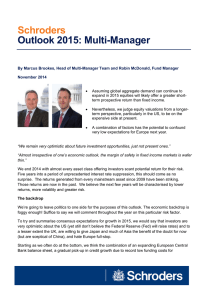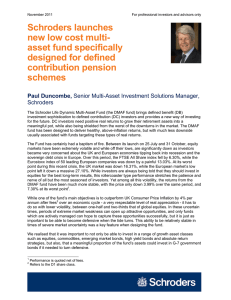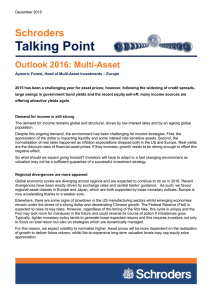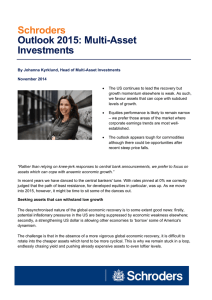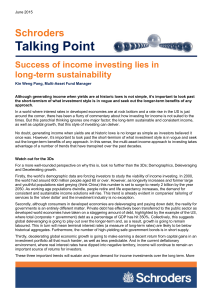Global Multi-Asset Income Fund Picture the perfect retirement
advertisement
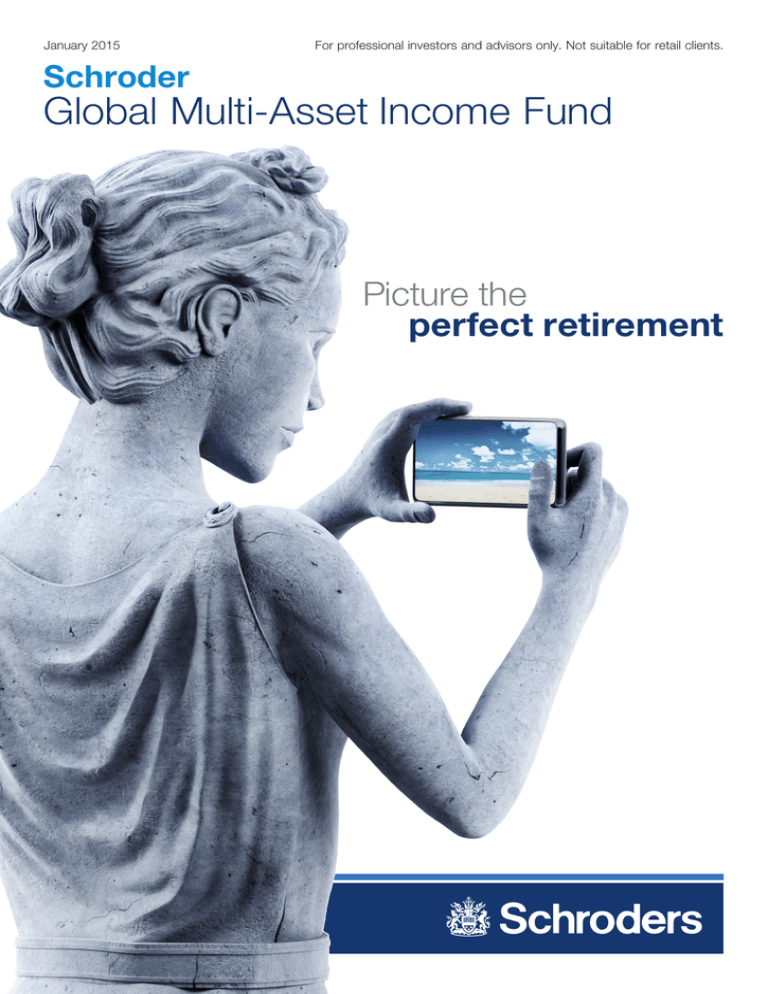
January 2015 For professional investors and advisors only. Not suitable for retail clients. Schroder Global Multi-Asset Income Fund Picture the perfect retirement G L O B A L M U L T I - A S S E T I N C O M E F U N D When designing the new Schroder Global Multi-Asset Income Fund, the needs of the newly empowered generation approaching retirement have been at the forefront of our minds. Generating a consistent income with a moderate risk profile is no-longer possible with a single simple investment. Before the 2008 crisis investors could receive a 5% yield by investing in government bonds with a 10 year maturity. As yields have dropped, investors seeking the level of income they were used to had little choice but to invest in riskier assets, pushing many investors out of their comfort zone in terms of risk exposure. Now there is a solution for those seeking a regular income at lower risk, in-line with a typical cautious managed fund, where many investors will be more comfortable. 2 G L O B A L M U L T I - A S S E T I N C O M E F U N D “Savers need to balance both risk and return very carefully when making their decisions rather than just focusing on either risk or potential return – they are always linked.” Robin Stoakley – Head of UK Intermediary, Schroders 3 G L O B A L M U L T I - A S S E T I N C O M E F U N D Rising to the income challenge The Schroder Global Multi-Asset Income Fund has been designed to help investors seeking income in the current low growth, low yield environment where traditional sources of income can no longer fulfil their requirements. It aims to provide an attractive, regular and sustainable income without a correspondingly heightened exposure to risk. As such, it could provide a complete income solution for a broad range of investors. Age 40 30 £ 50 70 60 £ Regular income Education planning Pension supplement Active retirement Health care In its March 2014 Budget, the UK Government announced that from April 2015, anyone aged 55 or above would be able to take their defined contribution pension pot however they want, subject to their marginal rate of income tax in that year. This change means that anyone with an accumulated pension pot has much greater flexibility and control over making financial plans for their retirement. The new Schroder Global Multi-Asset Income Fund has been designed with the needs of the newly empowered generation approaching retirement in mind. With accumulation and distribution share classes, it could offer an attractive solution for both the pre- and post- retirement phases as illustrated below: 4 1 Late stage of pre-retirement 2 Early stage of retirement –Capture income with less volatility than single asset class –Accumulation share class –Move into stable monthly income payments –Distribution share class G L O B A L M U L T I - A S S E T I N C O M E F U N D Targeting a clear outcome The fund has three objectives: 1 To provide a regular and sustainable income of 4-6% per annum, which can be paid monthly or accumulated within the fund 2 To generate a total combined return of 7% per annum 3 To deliver these returns with volatility in-line with a risk rating of 4 on a scale from 1-7. These target figures will be reviewed on an ongoing basis to ensure that market conditions continue to make them achievable. Please note that they are not guaranteed. A proven strategy The strategy is modelled on our successful offshore fund which launched in April 2012. It has been developed by our highly experienced Multi-Asset team, who currently manage over £4 billion5 in global multi-asset income strategies. Schroder ISF4 Global Multi-Asset Income performance 120 115 110 105 100 95 90 Apr 2012 Oct 2012 Apr 2013 Oct 2013 Schroder ISF Global Multi-Asset Income Schroder ISF Global Multi-Asset Income A Acc Apr 2014 US 10 Year Oct 2014 70/303 Year to date % Since inception1 p.a. % Yield2 % Annualised volatility % 5.0 7.0 5.0 3.9 Source: Datastream, Bloomberg, 30 November 2014, A Acc share class, net of fees. 1Annualised performance since inception date of 18 April 2012. Volatility is calculated using daily returns since inception. 2Yield is the next 12 months dividend yield using Schroders’ forecasts for the equities and using the current effective yield to maturity for the fixed income; it is gross of withholding tax. 370/30 reference is 70% JP Morgan GABI & 30% MSCI AC World. Past performance is not a guide to future performance and may not be repeated. 4Schroder International Selection Fund is referred to as Schroder ISF throughout this brochure. 5Source: Schroders as at December 2014. 5 G L O B A L M U L T I - A S S E T I N C O M E F U N D Strategy overview We believe it is necessary to focus on investing in high quality, liquid securities which can generate a sustainable income stream. In the case of equities, we look for securities that can grow their income streams in order to minimise the risk of capital loss. The fund employs a multi-asset approach that addresses the key drivers of sustainable income: quality, diversification and liquidity. It typically holds over 350 directly invested securities, principally in bonds and equities. Global approach Sourcing opportunities across asset classes, regions and sectors Flexible Able to move dynamically within asset classes with a view to ensuring we are adequately compensated for risk Not constrained by a benchmark Free to find yield opportunities wherever they exist and avoid some hidden benchmark risks £ Risk control Risk controlled by pursuing a diversified approach and monitoring risk at both a portfolio and security level. Liquidity risk is taken into account to maintain the flexible nature of the portfolio. 3 step investment process 1 2 Asset allocation 20 asset classes Equity security selection 3 Source: Schroders 6 Universe of over 10,000 securities Fixed income security selection Risk management overlay 40 countries Focus on identifying high but sustainable yields from quality income sources G L O B A L M U L T I - A S S E T I N C O M E F U N D Investing across equities, fixed income and alternatives Equities 0-40% Bonds 60+% The objective of our equity selection is to target a yield that is higher than the MSCI AC World Index. The team analyses a universe of approximately 2,400 developed and emerging market stocks to manage a diversified portfolio by investing in companies that offer an attractive and sustainable dividend yield. Sustainability is assessed using measures including company profitability, earnings stability, and financial strength. The diversified nature of the portfolio reduces stock-specific risk. £ Cash 0-20% The fixed income allocation is managed by Schroders’ Global Fixed Income Team with over 100 managers and analysts. They undertake fundamental screening, targeting high quality securities with a high yield to maturity. The investment process is both top-down, in that it takes account of the wider macroeconomic climate, and bottom-up, in the way it assesses individual securities. As with the equity analysis, the aim is to uncover those securities with a sustainable yield rather than simply a high headline figure. Valuation is a vital part of the investment selection – at all times, the fund managers are deciding whether the price of an investment adequately compensates for the risk taken. Alternative asset classes 0-10% The allocation to alternative investments can include property, infrastructure and municipal bond securities. The fund aims to invest in high-yielding securities from a universe of liquid, listed alternative asset classes that add to the portfolio on a yield-to-risk basis. Furthermore, by investing in these alternative asset classes the fund’s overall level of risk diversification is improved. 7 G L O B A L M U L T I - A S S E T I N C O M E F U N D The fund managers’ six principles for income investing 8 1 Focus on higher quality assets with sustainable income 2 Pursue a diversified approach 3 Take advantage of opportunities globally 4 Be flexible and not benchmark driven 5 Analyse risk and manage it carefully 6 Be careful when investing in passive income products One of the biggest risks in investing is the risk of permanent capital loss. Investing in higher yielding securities without paying attention to the security issuer’s future ability to pay dividends or meet coupon and principal payments, risks permanent capital loss. We believe it is imperative to focus on high quality securities that are able to sustain and grow their income. Investing in single asset classes for income can leave investors exposed to the specific risks inherent within those assets classes. Whether it is market risk in equities, liquidity risk in high yield debt or the political risk inherent in emerging market debt, these risks can lead to meaningful underperformance by particular asset classes. Investing across a spectrum of asset classes can help to diversify these risks with the potential to produce superior risk-adjusted returns. Investors who are geographically restricted, focusing too narrowly on their home market for example, have a reduced opportunity set compared to those investors who invest globally. Assets in certain regions can be expensive at points in time, while assets in other regions can simultaneously be cheap. By investing globally, investors can take advantage of opportunities in different regions whenever they present themselves. The value of asset classes is not consistent and can differ depending on the economic cycle. Therefore, a flexible approach that is not benchmark driven should be taken when managing exposure to different income sources. This allows investors to take advantage of relative value opportunities in different asset classes, styles and market cap sizes over time. It is important to understand the amount of risk being taken at both a security and portfolio level and to examine how a portfolio will perform in different market environments. We believe an active approach to risk management is necessary in protecting a portfolio during turbulent markets. As such it is necessary to understand the sources and portfolio implications of different types of risk. Investing in generic income products like ETFs can result in unnecessary exposure to avoidable risks. Income-focused equity ETFs can be highly concentrated in a small number of sectors, such as utilities, leaving investors exposed to regulatory risk. We believe investors should pursue more bespoke strategies. G L O B A L M U L T I - A S S E T I N C O M E F U N D Multi-discipline expertise The fund is co-managed by Aymeric Forest and Iain Cunningham. They are fund managers within our Multi-Asset team and manage the asset allocation and risk management within our Global Income Investment team, divided into equity, fixed income and multi-asset groups. The fund managers provide the asset allocation framework for the fund – allocating dynamically across bonds, equities, liquid listed alternatives and cash. The securities are then selected by the asset class experts on a bottom-up basis. Finally, the fund managers actively manage risk, looking at both the security level and the portfolio level with a view to ensuring that they avoid unrewarded risk. This means the fund is coherently managed as a single entity rather than simply ‘packaging’ together disparate strategies. The team shares information on market movements and positions daily, and meets on a regular basis to identify opportunities and risks, discuss themes and analyse the positioning of the portfolio. They benefit from full access to Schroders’ deep research capabilities, drawing on the experience of over 200 investment professionals. Aymeric Forest – Lead Fund Manager Aymeric Forest is lead fund manager and Head of Multi Asset Investments – Europe and has 18 years of investment experience. He joined Schroders in 2011 as a fund manager within Multi Asset. He is the lead manager of the Luxembourg registered Schroder ISF Global Multi-Asset Income, a member of Schroders’ Global Asset Allocation Committee and Volatility Risk Premia group leader. Iain Cunningham – Co-Fund Manager Iain Cunningham is co-fund manager and is responsible for the management of a number of multi-asset mandates that are principally focused on income and dynamic asset allocation. He joined Schroders in 2007 as a graduate trainee and specialises in currency and commodity research and is a member of Schroders’ Strategic Investment Group Multi-Asset (SIGMA). 9 What are the risks? –The value of investments and the income from them may go down as well as up and investors may not get back the amount originally invested. –Part of the fund is invested in bonds. The government or company issuer of a bond might not be able to repay either the interest or the original loan amount and therefore default on the debt. This would affect the credit rating of the bond and, in turn, the value of the fund. Investment in bonds and other debt instruments including related derivatives is subject to interest rate risk. The value of the fund may go down if interest rates rise and vice versa. –The fund may invest in higher-yielding, or non-investment grade, bonds. The risk of the issuer defaulting on the capital repayment is higher than with investment grade bonds. –The fund may invest in emerging markets equities. Potential investors in emerging markets should be aware that this can involve a higher degree of risk. –The fund holds investments denominated in currencies other than sterling, changes in exchange rates will cause the value of these investments, and the income from them, to rise or fall. –The fund can use derivatives for investment purposes. These instruments can be more volatile than investment in equities or bonds. –The income and capital growth targets are an estimate and not guaranteed. –If the fund’s income is not enough to cover the regular income payments, they may be sourced from investors’ capital. The value of the capital can therefore be eroded and investors may not get back the amount invested. –As a result of all fees being charged to capital, the distributable income of the fund may be higher but there is the potential that performance or capital value may be eroded. 10 T R U S T E D H E R I T A G E A D V A N C E D T H I N K I N G Schroders is an independent, dedicated asset manager with a strong heritage and culture based on over 200 years’ experience of investment markets. Listed in the UK, we benefit from a strong balance sheet and a stable ownership structure, which allows us to focus entirely on delivering results for our clients. With £276.2 billion funds under management and an international network spanning 37 offices in 27 countries, Schroders has the perspective and expertise to identify major investment potential wherever it is located. To find out more go to www.schroders.com or speak to your local representative. www.schroders.com Source: Schroders, as at 30 September 2014. Important information. Past performance is not a guide to future performance and may not be repeated. The value of investments and the income from them may go down as well as up and investors may not get back the amount originally invested. Details of the terms and risk warnings are contained in the Prospectus and Key Investor Information documents. Issued in January 2015 by Schroder Unit Trusts Limited, 31 Gresham Street, London EC2V 7QA. Registered No: 4191730 England. Authorised and regulated by the Financial Conduct Authority. w46393
